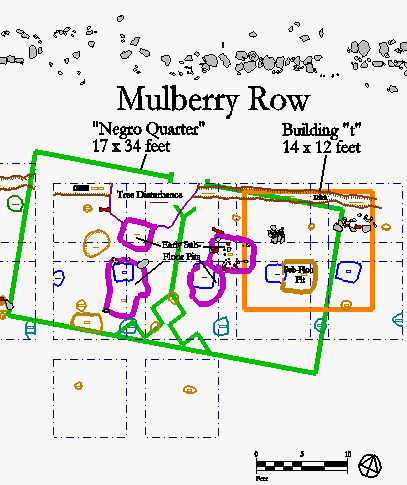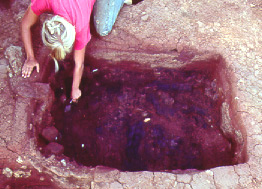
The only surviving evidence for the "Negro quarter" is four subfloor pits and possibly three postholes. Many lines of evidence point towards the pits being a part of the 17 by 34 foot, two celled quarter that Jefferson described in his ca. 1776-78 plan for Mulberry Row.  First, the material contained within the features suggest that a structure encompassed all four pits. High amounts of ash and charcoal, and the heating of the cellars' clay sidewall to a brick-hard consistency suggest that the two northern pits were filled as the result of the collapse of a still burning building. Preserved mud chinking from both lathing and logs of varying diameters support this conclusion. Second the four pits are not aligned along the final orientation of Mulberry Row. This suggests that the structure that they were a part of was constructed prior to Mulberry Row's completion in the early 1780s. Stratigraphically, the pits were also the earliest features at the site, reinforcing this interpretation. Finally, by using distances provided by the ca. 1776-78 plan of Mulberry Row, the approximate position of the 17 by 34 foot "Negro Quarter" was reestablished. Its center point rests in the space between the four subfloor pits, suggesting that the cellars pairs, east and west, conform to Jefferson's plan of two cells with a central chimney.
First, the material contained within the features suggest that a structure encompassed all four pits. High amounts of ash and charcoal, and the heating of the cellars' clay sidewall to a brick-hard consistency suggest that the two northern pits were filled as the result of the collapse of a still burning building. Preserved mud chinking from both lathing and logs of varying diameters support this conclusion. Second the four pits are not aligned along the final orientation of Mulberry Row. This suggests that the structure that they were a part of was constructed prior to Mulberry Row's completion in the early 1780s. Stratigraphically, the pits were also the earliest features at the site, reinforcing this interpretation. Finally, by using distances provided by the ca. 1776-78 plan of Mulberry Row, the approximate position of the 17 by 34 foot "Negro Quarter" was reestablished. Its center point rests in the space between the four subfloor pits, suggesting that the cellars pairs, east and west, conform to Jefferson's plan of two cells with a central chimney.
 The surviving structural evidence for building t was minimal. Only a single sub floor pit, measuring 3 by 3.5 feet was found within the map predicted location for the dwelling. The artifact assemblage is similar to what was found in the building s cellar, suggesting contemporaneity.
The surviving structural evidence for building t was minimal. Only a single sub floor pit, measuring 3 by 3.5 feet was found within the map predicted location for the dwelling. The artifact assemblage is similar to what was found in the building s cellar, suggesting contemporaneity.
Using both documents and archaeological evidence we see an architectural pattern emerging at Monticello. Slave quarters constructed prior to 1780 (building o, "Negro quarter") are larger than their later counterparts (building l, r, s, and t). Further, we see a decline in the number of subfloor pits contained within each building. This pattern mimics that of the Chesapeake region as a whole -- in the late eighteenth century there is a shift from large two-room structures to smaller one-room dwellings. Insight into a possible explanation for this shift can be found at the following research page.
